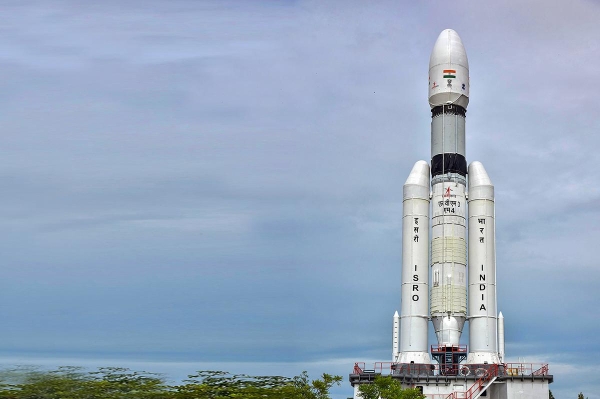‘Chandrayaan-3 mission to place India among top players,’ says former ISRO scientist Nambi Narayanan. Top 10 updates
The spacecraft will be launched on a GSLV Mark 3 (LVM 3). This will be a follow-up attempt by the Indian Space Research Organization (ISRO) after the Chandray
- by B2B Desk 2023-07-14 07:06:19
The upcoming Chandrayaan 3 mission of the Indian Space Research Organization (ISRO) is scheduled to take off from the Satish Dhawan Space Center in Sriharikota, Andhra Pradesh at 2:35 pm, IST on Friday, July 14.
Here are the top ten updates
- Mission follows Chandrayaan-2, where scientists aim to demonstrate various capabilities, such as access to lunar orbit, soft landing on the lunar surface with a lander, and a rover coming out of the lander to study the surface of the moon.
- Ahead of India's ambitious Chandrayaan 3 space programme, former ISRO scientist Nambi Narayanan on Thursday that its successful landing will make India only the fourth country to achieve this and increase the country's space science development potential.
- India's presence in the USD 600 billion industry is currently at a modest 2%. Narayanan also emphasized that with the introduction of private participation in technology development, there would be more possibilities for startups to enter the sector.
- A successful mission would see India enter an elite club of countries achieving this feat, the others being the United States, China and the former Soviet Union.
- The spacecraft will be launched on a GSLV Mark 3 (LVM 3). This will be a follow-up attempt by the Indian Space Research Organization (ISRO) after the Chandrayaan-2 mission ran into challenges during its soft landing in 2019.

- A day before the Chandrayaan-3 mission, a team of ISRO scientists on Thursday visited and offered prayers at the Tirupathi Venkatachalapathy Temple in Andhra Pradesh with a miniature model of Chandrayaan-3. If all goes well, Chandrayaan-3 will be the first spacecraft to land on the moon's south pole, demonstrating India's technical prowess and bold spacefaring ambitions.
- The Chandrayaan-3 mission will demonstrate a safe and soft lunar landing, a lunar surface, and rover roving experiments on the moon. ISRO has invited citizens to witness the long-awaited launch of Chandrayaan-3 from the viewing gallery at Sriharikota. During the Chandrayaan-2 mission, ISRO lost contact with the lander when it was only 1 degree from the lunar surface.
- Upon landing, it will operate for one lunar day, which is about 14 Earth days. One day on the moon equals 14 days on earth. K Sivan, the former director of ISRO, told ANI that the success of the Chandrayan-3 mission would give a morale boost to programs like Gaganyan.
- Chandrayaan-3's development phase began in January 2020 with plans to launch it sometime in 2021, but the COVID-19 pandemic caused delays in the development process. The biggest discovery of the Chandrayaan-1 mission, which was launched in 2008, is the detection of water (H2O) and hydroxyl (OH) on the lunar surface. The data also revealed greater abundance towards the polar region.
10- The primary scientific objective of the mission was to prepare a three-dimensional atlas of the near and far sides of the moon and to conduct chemical and mineralogical mapping of the entire lunar surface with high spatial resolution, ISRO's Vikram Sarabhai Space Center said.
Also Read: ZappFresh buys Bengaluru firm Dr. Meat to foray into Southern market

POPULAR POSTS
Loan EMIs to Drop as RBI Slashes Repo Rate - Full MPC December 2025 Highlights
by Shan, 2025-12-05 11:49:44
Zoho Mail vs Gmail (2025): Which Email Platform Is Best for Businesses, Startups, and Students?
by Shan, 2025-10-09 12:17:26
PM Modi Launches GST Bachat Utsav: Lower Taxes, More Savings for Every Indian Household
by Shan, 2025-09-24 12:20:59
$100K H-1B Visa Fee Explained: Trump’s New Rule, Clarifications & Impact on Indian Tech Workers
by Shan, 2025-09-22 10:11:03
India-US Trade Deal Soon? Chief US Negotiator Arrives in Delhi as Talks Set to Begin Tomorrow
by Shan, 2025-09-15 11:54:28
Modi Meets Xi: Trump’s Tariffs, Strategic Autonomy, and the Future of Asia’s Power Balance
by Shan, 2025-09-03 06:40:06
Google Claims Gemini AI Uses Just ‘Five Drops of Water’ Per Prompt, Sparks Debate
by Shan, 2025-08-22 12:34:27
RECENTLY PUBLISHED

Pine Labs IPO 2025: Listing Date, Grey Market Premium, and Expert Outlook
- by Shan, 2025-11-05 09:57:07

The Agentic Revolution: Why Salesforce Is Betting Its Future on AI Agents
- by Shan, 2025-11-05 10:29:23

Top 10 Insurance Companies in India 2026: Life, Health, and General Insurance Leaders Explained
- by Shan, 2025-10-30 10:06:42

OpenAI Offers ChatGPT Go Free in India: What’s Behind This Big AI Giveaway?
- by Shan, 2025-10-28 12:19:11

Best Silver Investment Platforms for 2025: From CFDs to Digital Vaults Explained
- by Shan, 2025-10-23 12:22:46





 Subscribe now
Subscribe now 